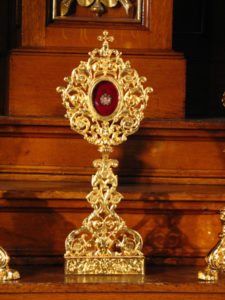Śarīra is a beautiful word essentially connoting a Buddhist relic, “although in common usage it usually refers to pearl or crystal-like bead-shaped objects that are purportedly found among the cremated ashes of Buddhist spiritual masters.” (Wiki) The Mahaparinibbana Sutta makes reference to them after the Buddha’s cremation, after which they are referred to as dhātu and are “held to emanate or incite ‘blessings’ and ‘grace’ (Sanskrit: adhiṣṭhāna) within the mindstream and experience of those connected to them.” (Wiki) A Greater breakdown would signify the following:
Relics can be pieces of the material body—a tooth, a bone, dried up flesh, odd crystalline derivates of the cremated body, or material items associated with a Buddha—clothing, ritual items, or other possessions. They can also be verbal, as encapsulated in the Buddhist scriptures, believed to have persisted orally in the hearts and minds of disciples before being committed to written, canonical form. Indeed it has been argued that stupas, images, and a wide spectrum of other items believed to derive from, emulate, represent, or incarnate a Buddha’s presence should be considered relics. (Embodying the Dharma, Buddhist Relic Veneration in Asia)
There are certain parallels within Christendom, such as the tradition of housing purported fragments of the True Cross of Christ in a reliquary. I remember certain parishes used to present such a reliquary for reverence during their Good Friday services, the second part of the larger Triduum commemorating Jesus’ suffering and death on the cross.
While both within Buddhism and Christianity relics constitutes strong popular devotion, in scholastic circles they are sometimes frowned upon and downplayed. One such critic, American Monist Paul Carus, who wrote The Gospel of the Buddha, once refused the offer of a Buddhist relic from a Sri Lankan monk, telling him:
“The worship of relics, be they bones, hair, teeth, or any other substance of the body of a saint is a mistake…the soul of a Buddha is not in his bones, but in his words, and I regard relic-worship as an incomplete development in which devotees have not as yet attained to full philosophical clearness.” (John S. Strong, Relics of the Buddha)
It’s interesting how another scholar, Robert Sharf, mentioned in our previous blog, plays the hero this time and counteracts this stance with the following:
“It is no longer acceptable to dismiss causally the worship of relics and images as aberrant or un-Buddhist, as a sop to the plebeian needs of the unlettered masses. Scholars now appreciate that, with few exceptions, the clerical elite found nothing objectionable in the worship of relics, but enthusiastically engaged in and promoted such activities themselves. There is thus little reason to believe that the display of relics contravenes either the letter or the spirit of Buddhist teachings.” (ibid)
Let us turn briefly now to the early account of the “distribution” of cremated remains of the Buddha as found in the Mahaparinibbana Sutta. In reply to Ananda’s question about what should be done with the Tathagata’s body after His Parinibbana, the Buddha indicated that “it should be cremated like the body of a Universal monarch and the corporeal remains from the cremation should be honored by stupas erected over them at the crossroads.” Afterwards the following occurred:
Sometime after the division of the physical remains of the Buddha and their enshrining in various kingdoms, Mahākāśyapa began to worry about their dispersal, and, together with King Ajātaśatru, he took steps to collect them so that there could be “a single enshrinement of the relics”. This too took place near Rājagṛha. Later, King Aśoka discovered the spot and undertook the orderly redistribution of these relics into eighty-four thousand stūpas all over his empire, so that today Buddha relics may be found throughout the Buddhist world. (John S. Strong, The Buddha, A Beginners Guide.)
All this has much to do with what is known as “the rubric of presence in absence”:
This rubric of presence in absence has proved particularly, and I think understandably, alluring. For one thing, it renders the worship of relics and images consonant with Buddhist doctrine. The relic is a potent vestige of the death of an enlightened being, a memento of his or her abiding liberation. The same holds true for the image of the Buddha and his stupa—they all signify the unfathomable freedom of nirvana. By instantiating a numinous absence, relics, images, and their kin function as a physical locus for the saint’s enduring charisma, apotropaic power, and grace. This argument has been made by a number of Buddhologists, including David Eckel, John Strong, and myself on several occasions. (Robert Sharf, On the Allure of Buddhist Relics.)
There’s also a tradition which states that:
“Just prior to the advent of Maitreya all the relics of the Buddha—including those in the nāga world and those in the realms of the gods—will come together at Bodhgaya. None, not even those that are but the size of a mustard seed, will be lost en route. At Bodhgaya, they will reassemble and take on the form of the Buddha’s body, complete with its thirty-two major and eighty minor marks, and in midair, they will perform once again the “twin miracle” like the one the Buddha performed during his lifetime, at Śrāvastī.” (John S. Strong, Buddhist Relics in Comparative Perspective: Beyond the Parallels.)
It’s interesting to propose that during the age of the Final Dharma, i.e., when the Buddhadharma will totally disappear, only to be rediscovered and reintroduced by the future Buddha Maitreya, that all of this will occur perhaps on some other world, or even a different dimension from our accustomed one. What that dimension will be like can be experienced now via the receptacle of śarīras—which mentioned in the last blog post can act as “Mind-Portals” to these sacred dimensions. In this sense śarīras are like little nuggets of gold, jasmine buds or washed dharma-pearls that represent the sacred mani-pearl of Unborn modes of being. One such meditative technique opening these Dharma-doors is represented by what is known as a Bodhisattva monstrance, a figure kneeling and holding up a sacred volume of the Buddhadharma:
Notice how the Bodhisattva is kneeling on a lotus-shaped dais (circa 871 CE), and that he’s holding aloft the sacred text which is itself resting on a Lotus Leaf:
This is all representative of how this is a marvelously synthesized organic-process. The practitioner, reliquary and Buddhadharma all becoming One. The portal is now open, and oh what splendid Dharma-treasures will be revealed.





good work